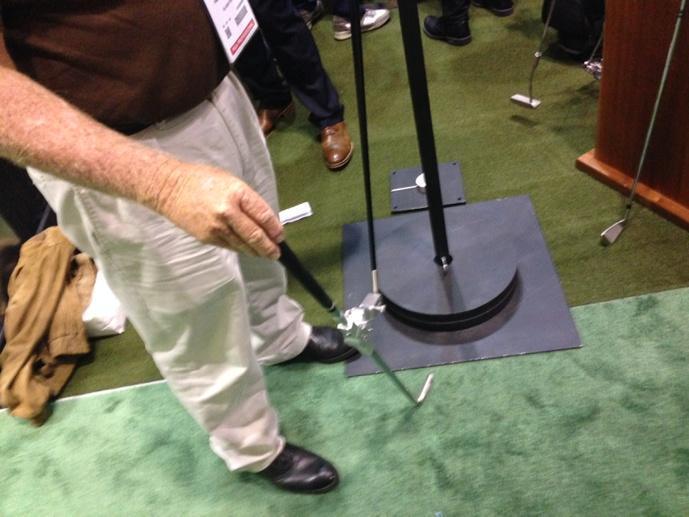A few weeks ago my dad and I were discussing a subject and he recalled one of the best pieces of advice that my grandfather (his father and long deceased) gave him.
"You can’t fault a person for trying to better themselves."
My grandfather was a WWII hero. Fought in Patton’s 3rd Army and was awarded the Silver and Bronze star. Not bad for a guy that quit school in 7th grade, lied about his age so he could join the merchant marines at 13 years old, get shipped all the way out to Idaho so he could chop trees as the country got out of the Great Depression for $30 a month, giving $20 of that back to his parents in New York. He eventually made a good living for himself as a linesman for a power company and supervisor. He did it by trying to make a better life for himself instead of hoping that would just magically come to him.
Not too long ago, HBO’s John Oliver did some comedic commentary on his show discussing how he loves the American’s attitude of constant optimism. Oliver pointed out that in England there is little optimism.
Why?
Because England was brought up on a rigid class system. For centuries in England, you were more or less assigned to a certain position and status in life regardless of how hard you work, how talented you are and what you bring to the table.
In the US, we’ve seen it all. As the late Patrice O’Neal said, there is always that mentality of ‘winning the lottery’ because it does happen. People from the most humblest beginnings go on to achieve great things. And as children we are constantly taught that "if you put your mind to it, you can accomplish anything."
This type of optimism has created so many great people that have accomplished so many great things, like Tiger Woods. Without the belief that this is the Land of Opportunity, there would be no Tiger Woods. He would just be resigned to being in the armed forces like his father.
And that’s why you can’t fault a person for trying to improve themselves. It’s the basic tenet of what this country was built on regardless of race, gender, religious or political beliefs. Do your best and the possibilities are endless.
Since being able to accomplish great things requires a person to put their mind to it, that means not only hard work, but the willingness to take risks, change things when they don’t meet your expectations and striving to get better and doing whatever it takes to reach that goal. And that is exactly what Tiger has done over his career. He’s made roughly a handful of swing changes. Some have worked greatly, some have not.
Recently, what has become most disturbing to me is the sarcastic remarks from the media for Tiger trying to change his swing and for him working with Chris Como, a golf instructor who supposedly is some sort of fraud just because he dared to go to college to earn his Masters Degree in biomechanics. In fact, this video of Chris making a swing off a diving board drew the ire of the sarcastic Rocco Mediate on last night’s Feherty show:
So, let me get this straight….the TV critics agreed and clamored for Tiger to dump Sean Foley (who did statistically improve his driving and won 8 events from 2012 to 2013 with) and change his swing.
And now that he has decided to dump Foley and change his swing, it’s a dumb move?
But, getting back to Chris Como…there seems to be a real fear towards golfers daring to educate themselves about the swing.
Chris is currently an academic. He is using school money and school resources to conduct research about biomechanics involved with the golf swing. Having to show his work, create high level technical jargon in dissertations along with doing crazy things like jumping off a diving board to show what the swing would look like if the golfer was not hitting off the ground comes with the territory.
And by the way, Joe 10 Handicap and even Johnny Tour Pro are not his target audience for those dissertations, thesis papers and videos. But by the TV critics logic and people like Rocco Mediate, why study the golf swing and try to improve yourself as an instructor and try to improve your students? You’re merely set into a rigid station in golf so doing that research and study is pointless. Ironic given that Mediate's long time teacher, Jimmy Ballard, doesn’t have a playing background and would have never left a Pell City, Alabama driving range if he had never discarded what the older guard of instructors were teaching the golf world and did his own thing.
This isn’t to say that criticizing the findings and interpretations along with the application of Chris’ work is wrong. That is perfectly legitimate. I just don’t see the anti-education sentiment that comes from the media critics. Instead of criticizing the findings, interpretations, research methods, applications, etc. they seem to have the belief that because they are unwilling to take the time to understand what somebody like Chris is doing, then trying to educate yourself (aka improving yourself) alone is a ‘bad’ thing.
Furthermore, Tiger trying to better himself is now apparently a bad thing. That and supposedly he should work on his swing in 3-4 months (while coming off an injured back) and he should be back to his old self and never revert back to some of his old swings. In other words, trying to better yourself should happen overnight in their eyes and if it doesn’t, well…give up trying.
Excuse me, but that's just logic that I’m not familiar with.
And I don't think Tiger is familiar with it either.
3JACK
Friday, January 30, 2015
Wednesday, January 28, 2015
Victor Rodriguez Swing on Swing Catalyst
Here is Victor Rodriguez's golf swing on the Swing Catalyst. With a 'standard' stock driver his club head speed is at 129 mph. With his 'gamer' it is at 137 mph.
According to the Swing Catalyst, Victor's pressure is at 100% on his rear foot at the top of the swing and in transition transfers from 100% rear to 89% front.
I watched Victor hit balls at Lucas Wald's 2-Day School in Orlando and not only does he hit the ball long with towering trajectories, but he also hits the ball extremely straight and he can work the ball left to right and right to left, low and high on command. And he's only 19 years old! During the past couple of years of studying Kelvin Miyahira's work and work with Lucas the past couple of months, his club head speed has increased by 30 mph!
Yes, you read that correctly.
Great job from Victor and I look forward to seeing more from you in the future.
3JACK
According to the Swing Catalyst, Victor's pressure is at 100% on his rear foot at the top of the swing and in transition transfers from 100% rear to 89% front.
I watched Victor hit balls at Lucas Wald's 2-Day School in Orlando and not only does he hit the ball long with towering trajectories, but he also hits the ball extremely straight and he can work the ball left to right and right to left, low and high on command. And he's only 19 years old! During the past couple of years of studying Kelvin Miyahira's work and work with Lucas the past couple of months, his club head speed has increased by 30 mph!
Yes, you read that correctly.
Great job from Victor and I look forward to seeing more from you in the future.
3JACK
Tuesday, January 27, 2015
Tom Wishon on Bending Hosels to Meet Specs
Recently, golf instructor Joe Mayo (twitter.com/TrackmanMaestro) stated that he felt that Driver lie angles were too upright.
I think that is an interesting insight. We know from Trackman that the 'standard' vertical swing plane with irons is at 60 degrees. Typically, 5-irons are made with a 60 degree lie angle. Then the lie angles become more upright as the club becomes shorter.
Why?
The lie angle changes as the club is shorter or longer. As the club gets shorter the lie angle is effectively flatter. Therefore, the lie angle is designed more upright to counter than shorter length.
With the driver, the 'standard' vertical swing plane is set at 45 degrees (15 degrees flatter than the standard VSP for irons). It's a much longer club and therefore the VSP is swung on a flatter 'plane.'
However, the typical driver lie angle is only at 58 degrees. The typical 5-iron is set at 38" long (with grip) and the typical driver is set at 45.5" long. So we have a 7.5 inch difference in shaft length, but only a 2 degree difference?
According to Tom Wishon, ever 1/2" in shaft difference equates to 1-degree of lie angle. Now have state that it is less than that, but for now I'll take Tom's word for it. So if you were to use that logic at 7.5 inch difference, that would equate to a 15 degree in lie angle (fits right in line with the differences in Vertical Swing Plane).
The only issues are:
1. We are teeing the ball up
2. We have to account for shaft droop.

So, it's not going to be a lie angle of 45 degrees. It has to be more upright to account for those factors.
As we should know by now...OEM's generally make equipment for higher handicap players in mind. Not only do higher handicaps tend to have the handle higher at impact which leads to more toe shots, but they tend to have softer shafts that can lead to more shaft droop. That would lead to OEM's designing a driver with upright lie angles. But a golfer that is less than a 5 handicap and plays with stiffer shafts and shafts that have less shaft droop, may need much flatter lie angle with the driver.
This may explain part of the problem that golfers have with hitting longer drivers. It may make the club too upright for them as the club is already too upright. And they end up going to a shorter driver and hitting it better because the lie angle effectively flattens more.
So that is a good observation from Joe Mayo. Here's a video from Tom Wishon discussing bending the hosel to fit the specs.
3JACK
I think that is an interesting insight. We know from Trackman that the 'standard' vertical swing plane with irons is at 60 degrees. Typically, 5-irons are made with a 60 degree lie angle. Then the lie angles become more upright as the club becomes shorter.
Why?
The lie angle changes as the club is shorter or longer. As the club gets shorter the lie angle is effectively flatter. Therefore, the lie angle is designed more upright to counter than shorter length.
With the driver, the 'standard' vertical swing plane is set at 45 degrees (15 degrees flatter than the standard VSP for irons). It's a much longer club and therefore the VSP is swung on a flatter 'plane.'
However, the typical driver lie angle is only at 58 degrees. The typical 5-iron is set at 38" long (with grip) and the typical driver is set at 45.5" long. So we have a 7.5 inch difference in shaft length, but only a 2 degree difference?
According to Tom Wishon, ever 1/2" in shaft difference equates to 1-degree of lie angle. Now have state that it is less than that, but for now I'll take Tom's word for it. So if you were to use that logic at 7.5 inch difference, that would equate to a 15 degree in lie angle (fits right in line with the differences in Vertical Swing Plane).
The only issues are:
1. We are teeing the ball up
2. We have to account for shaft droop.

So, it's not going to be a lie angle of 45 degrees. It has to be more upright to account for those factors.
As we should know by now...OEM's generally make equipment for higher handicap players in mind. Not only do higher handicaps tend to have the handle higher at impact which leads to more toe shots, but they tend to have softer shafts that can lead to more shaft droop. That would lead to OEM's designing a driver with upright lie angles. But a golfer that is less than a 5 handicap and plays with stiffer shafts and shafts that have less shaft droop, may need much flatter lie angle with the driver.
This may explain part of the problem that golfers have with hitting longer drivers. It may make the club too upright for them as the club is already too upright. And they end up going to a shorter driver and hitting it better because the lie angle effectively flattens more.
So that is a good observation from Joe Mayo. Here's a video from Tom Wishon discussing bending the hosel to fit the specs.
3JACK
Monday, January 26, 2015
The Week That Was --- The PGA Merchandise Show
The PGA Merchandise Show was this past week and I had an excellent time looking at the new merchandise and meeting so many people in the industry.
Tuesday was Demo Day at Orange County National. Demo Day is always packed and this was no exception. The weather was about high 60’s and gloomy out. I went to the Convention Center first to pick up my badge and then took the Shuttle over to OCN. For the past 3 years, the shuttle has been playing the same Yamaha golf cart with Lee Trevino commercial with the same jingle. It’s gotten to the point that I know that Yamaha has EFI which stands for Electronic Fuel Injection which means no choke and no smoke and that Lee has never had to change a spark plug. This is what audio torture must be like.
One of the big newcomers that was at Demo Day was the new Hogan irons:
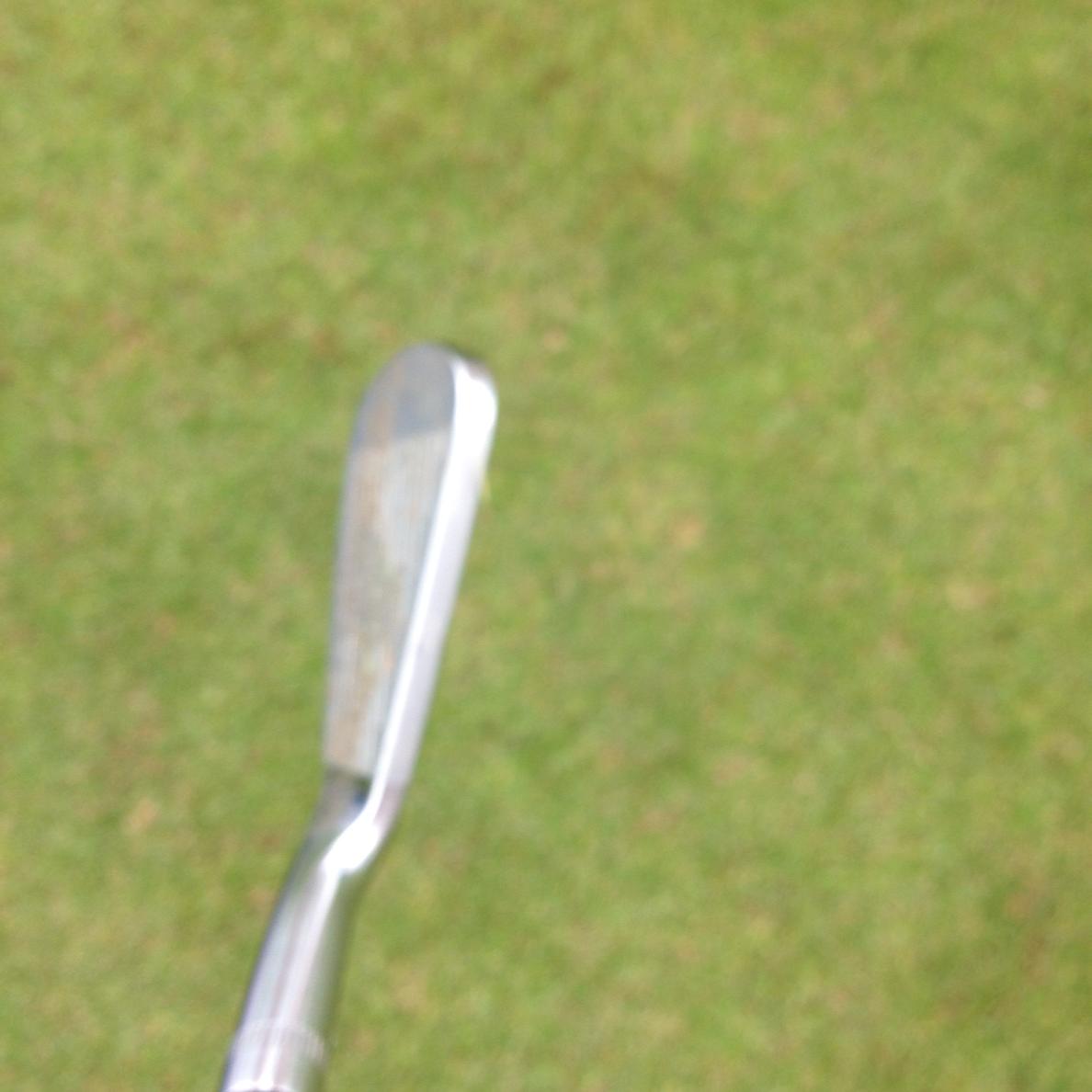

IIRC, these are being designed by the same people that own SCOR wedges. You can find their web site at: www.benhogangolf.com/
These have a similar look to Wishon Golf’s 575MMC irons where some of the muscle is cut out. They also build the clubs in 1 degree loft increments so they can individually custom fit the loft for each club. They generally find that there should be 4-degree loft increments in the long irons and 3-degree loft increments in the shorter irons.
Some people were put off by the thick top line, but as an owner of 5 different sets of vintage Hogan irons, I can tell you that Hogan designed their irons with a fairly thick top line and much thicker than most people would imagine.
But, they do feature the blade-on-blade design with the SCOR V-Sole. They will retail for roughly $150 a club in steel shaft and $165 a club in graphite.
I’ve come to believe that Yonex is the most underrated irons OEM out there. A few years ago I fell in love with their EZone Blades and then last year I fell in love with their Ti-Hybrid MB which features titanium inserted into the middle of the club head. This year they are coming out with a Cavity Back model with Graphite inserted into the head.

And I have to say, Yonex did it again with making this club feel and perform fantastic. Unfortunately, they will cost you an arm, leg and some spare organs to purchase.
The most interesting design of a club was the BioMech putters (www.biomechsports.com). As you can see, they have a similar design to the YAR putter with the hole in the middle of the head.
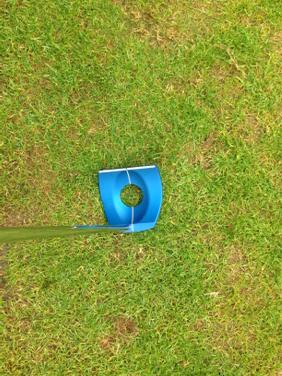
It’s a design to incorporate the handle pressed against the left forearm like Matt Kuchar does.
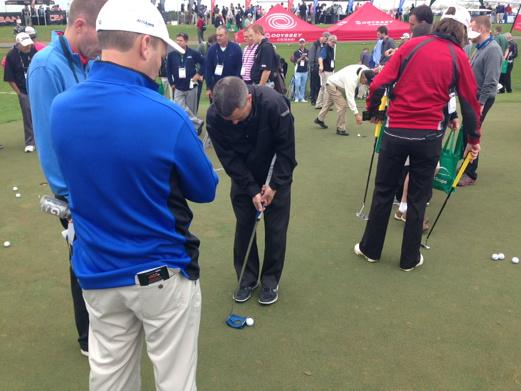

Tuesday night was the Open Forum 3 held in the ballroom at the Rosen Plaza Hotel right next door to the Convention Center. The first 2.5 hours consisted of Dr. Young-Hoo Kwon explaining his research and findings in the world of Ground Reaction Forces. I was told that the Open Forum had somewhere close to 400 attendees and they could not have picked a better venue as the Rosen Plaza was flat-out tremendous and they filled the place for Dr. Kwon’s presentation and everybody in that room was listening intently.
After Dr. Kwon I was on a panel that consisted of statisticians involved in the game which included Dr. Mark Broadie (Every Shot Counts), Dave Wedzik (golfevolution.com and Lowest Score Wins book), Erik Barzeski (golfevolution.com and Lowest Score Wins book), Stuart Leon (shotstohole.com) and Scott Fawcett (playinglesson.com). We briefly discussed statistics in the game and how golf instructors can use that to help assist them with their instruction.
I had a great time talking to Scott as he is involved with course strategy, mostly for amateurs. He’s a former Tour player himself and uses data and formulas to determine what the best strategies are. His work is very specific compared to mine when it comes to course strategy, but we agreed that laying up and ‘just trying to hit fairways and greens’ is a low-odds strategy that plagues a lot of golfers. I found his thoughts fascinating.
Wednesday morning I had a putting lesson with John Graham (www.johngrahamgolf.com) which golf instructor and friend, Brendan Kennedy, set up for us to use his course’s putting green at Legacy Club at Alaqua Lakes. I’ve played Legacy Club at Alaqua Lakes over the years and the course looks in fantastic shape and the staff is always extremely cordial and helpful. If I lived over there, it would be the place I would look to be a member at as they give you the 5-star treatment at a 5-star course.
I had worked on the SAM Puttlab before, but never really got into the stroke mechanics. And every SAM puttlab lesson I had ever seen they use the SAM Puttlab indoors. John actually uses it outdoors on the putting green and measures the golfer on straight uphill putts, a right-to-left putt and a left-to-right putt.
My main issue was that I was usually missing left except on straight short putts where the tendency was to miss right.
I had also read Erik Barzeski’s article on how you should *not* accelerate the putter (http://thesandtrap.com/t/74295/putting-do-not-accelerate-through-the-ball)
I perfectly agree with Erik’s article, just implementing it was another issue.
What John found was that:
1. I aimed too far right on straight uphill and right-to-left putts.
2. I then incorporated a cut-across stroke.
3. I accelerated the putter head into impact
With left-to-right putts I would actually aim too far left…but, I actually putt quite well on left-to-right putts.
John didn’t try to work that much on #2. Instead, we agreed that by accelerating the putter head into impact the face was shutting thru impact. And my guess is on those short straight putts, I may not accelerate as much, but the poor aim was causing me to miss right.
After that diagnosis, we worked on some setup and aiming along with making some changes to the backstroke to help with getting rid of the acceleration.
I learned more about the stroke than I have ever learned in my entire life. I give John the highest recommendation and he is an expert at AimPoint as well. I believe he is in Naples, Florida this week available for putting instruction.
After the lesson I went to the show at the Convention Center. I took a look at the MySwing Golf Motion Capture. To me, that was the big hit of the show. Excellent motion capture with data that can be done outdoors or indoors as it is wireless. It only takes about 10 minutes to put on and calibrate along with only weighing a few grams. They have a pro version which has 17 sensors from head-to-toe. Noted biomechanist Phil Cheetham is now working with the company.
I also had lunch with my editor from GolfWRX, Zak Kozuchowski and we discussed some things and came up with some good ideas for the Web site. That while I wasn’t distracted by PGATour.com’s Amanda Balionis having lunch in the table next to us.
Nope, not at all.
From there I did a walk-around and saw that Piretti has a new line of irons coming out.
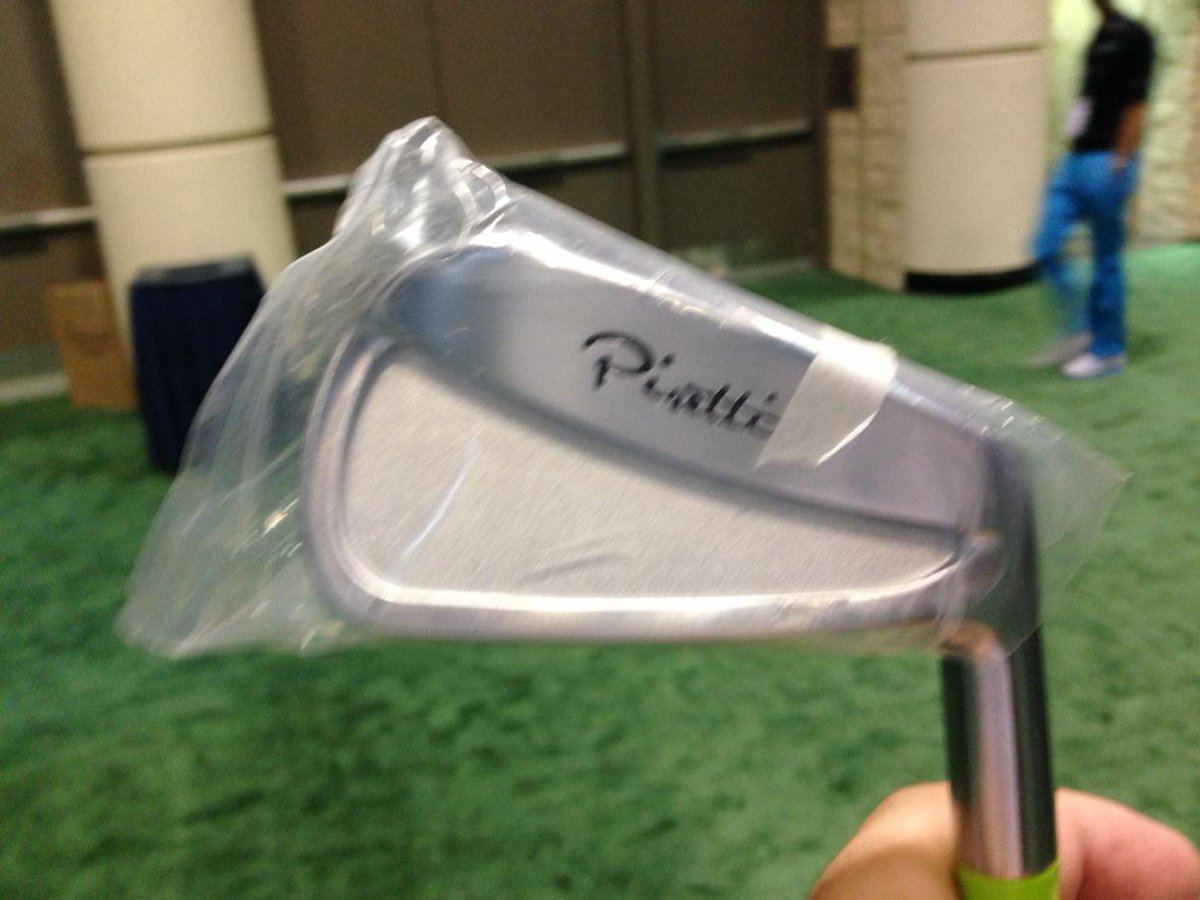

I also went over to the Edel booth where they were showing the ‘Groover’ swing instruction aid.
This is an aid that hangs onto a pole and you attach your golf club to. We’ve seen similar swing training aids like this one before, but the difference is that this one is designed towards how you wrists naturally hinge. And if you are struggling with one particular area (i.e. swinging too far inside-to-out), you can position yourself differently on The Groover so it trains you to swing more left.
Here’s a pic of Edel’s 8-iron:

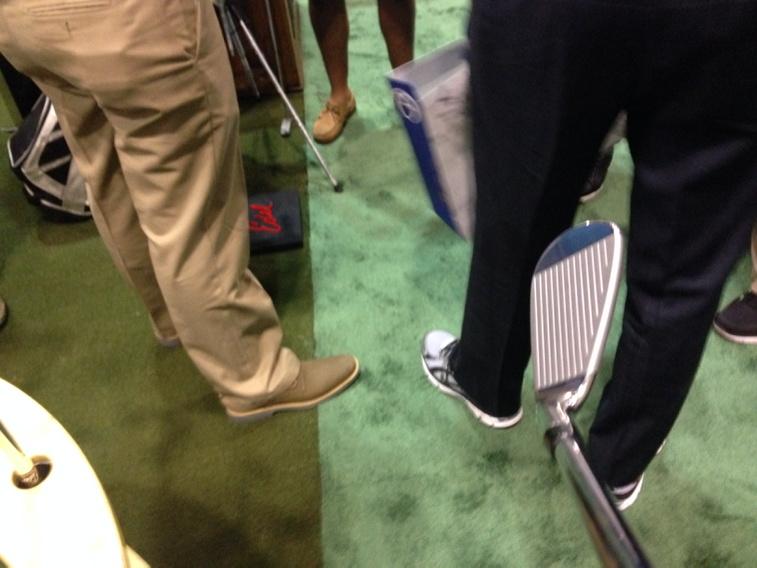
And here is a pic of a few of their wedges that I really liked:

Later on Wednesday night was Tweet-Up 4.0. This time it was at Miller’s Ale House. Tweet-Up is really about getting together with people and having a good time and talking about golf on the side. I’ll try to run down the people I met there and at the show or Open Forum:
John Dochety (twitter.com/JohnDochety)
Phil Snow (Trevinogolfinstitute.com)
Chris Trevino (Trevingolfinstitute.com)
Matt Newcomer (Trevingolfinstitute.com)
Jeff Martin (jeffygolf.com)
Lucas Wald (lucaswald.com)
Victor Rodriguez
Lloyd Higley (chicagogolfacademy.com)
Preston Combs (yourpargolf.com)
John Graham Justin Blazer (twitter.com/blazer_justin)
Sara Dickson (saradickson.com)
Megan Padua (meganpaduagolf.com)
David Graham (twitter.com/graham_golf)
Mark Blackburn (blackburngolf.com)
Nick Chertock (golfprogress.com)
Virgil Herring (www.hpga.net)
Andrew Rice (andrewricegolf.com)
Mike Adams (www.mikeadamsgolf.com)
Bobby Dean (edelgolf.com)
Peter Gauthier (twitter.com/myswingpro)
Joe Mayo (twitter.com/trackmanmaestro)
Dan Carraher (dancarrahergolf.com)
James Ridyard (jamesridyardgolf.com)
Chuck Evans (who looks fantastic, by the way --- chuckevansgolf.com)
Mark Csencsits (lehighvalleygolfpro.com)
John Ortega (http://www.costamesacountryclub.com/john-ortega)
Phil Cheetham (philcheetham.com)
I’m sure I missed people because…well, I suck.
But, I had a pleasure of talking to so many people and talking about the game and golfer performance. Probably the most common compliment I got was the study I did on hitting the driver versus the 3-wood off the tee and how that freed up so many people on the golf course and how they started playing better just because of that.
That and the encouragement on my work was something I really appreciated and was a bit overwhelming, in the very best sense of the word.
I was out of town for Thursday and Friday and part of Saturday. But on Sunday and stopped by the Lucas Wald 2-day school at Timacuan Golf and I got to see his students hit the ball and it was quite impressive. It wasn’t a school where players would hit shot after shot, but it was more about the patterns that Lucas teaches and how to practice them thru ‘deliberate practice.’ Some of the transformations were already impeccable.
One of the biggest things I have heard is that you can’t teach that! in reference to certain students who generate tons of club head speed. But, not only did Lucas teach himself to gain 12 mph of club head speed (along with the help of Kelvin Miyahira’s golf instruction), but they were able to increase Victor Rodriguez’s club head speed by nearly 30 mph!
There is also the assumption that if you learn how to swing faster using Lucas (or Kelvin’s) instruction that you will hit it crooked. But as Victor showed repeatedly, he hits the ball almost dead straight. Victor was measured at 137 mph on FlightScope. One of Lucas’ students, Sofia Amoroso who is 13 or 14 years old generated 93 mph on FlightScope (LPGA average is 94 mph) and she also hits it dead straight. But, I also saw some other golfers that were using Lucas’ practice methodologies improve right before my eyes.
Afterwards, we went out for some drinks and dinner which included myself, Victor, Jeff Martin, Lloyd Higley, Lucas and another one of Lucas’ students and had fun conversations discussing the game and the ungodly shots that Victor can produce.
It was a fun time and a great learning experience. But for now, I’m exhausted.
3JACK
Tuesday was Demo Day at Orange County National. Demo Day is always packed and this was no exception. The weather was about high 60’s and gloomy out. I went to the Convention Center first to pick up my badge and then took the Shuttle over to OCN. For the past 3 years, the shuttle has been playing the same Yamaha golf cart with Lee Trevino commercial with the same jingle. It’s gotten to the point that I know that Yamaha has EFI which stands for Electronic Fuel Injection which means no choke and no smoke and that Lee has never had to change a spark plug. This is what audio torture must be like.
One of the big newcomers that was at Demo Day was the new Hogan irons:


IIRC, these are being designed by the same people that own SCOR wedges. You can find their web site at: www.benhogangolf.com/
These have a similar look to Wishon Golf’s 575MMC irons where some of the muscle is cut out. They also build the clubs in 1 degree loft increments so they can individually custom fit the loft for each club. They generally find that there should be 4-degree loft increments in the long irons and 3-degree loft increments in the shorter irons.
Some people were put off by the thick top line, but as an owner of 5 different sets of vintage Hogan irons, I can tell you that Hogan designed their irons with a fairly thick top line and much thicker than most people would imagine.
But, they do feature the blade-on-blade design with the SCOR V-Sole. They will retail for roughly $150 a club in steel shaft and $165 a club in graphite.
I’ve come to believe that Yonex is the most underrated irons OEM out there. A few years ago I fell in love with their EZone Blades and then last year I fell in love with their Ti-Hybrid MB which features titanium inserted into the middle of the club head. This year they are coming out with a Cavity Back model with Graphite inserted into the head.

And I have to say, Yonex did it again with making this club feel and perform fantastic. Unfortunately, they will cost you an arm, leg and some spare organs to purchase.
The most interesting design of a club was the BioMech putters (www.biomechsports.com). As you can see, they have a similar design to the YAR putter with the hole in the middle of the head.

It’s a design to incorporate the handle pressed against the left forearm like Matt Kuchar does.


Tuesday night was the Open Forum 3 held in the ballroom at the Rosen Plaza Hotel right next door to the Convention Center. The first 2.5 hours consisted of Dr. Young-Hoo Kwon explaining his research and findings in the world of Ground Reaction Forces. I was told that the Open Forum had somewhere close to 400 attendees and they could not have picked a better venue as the Rosen Plaza was flat-out tremendous and they filled the place for Dr. Kwon’s presentation and everybody in that room was listening intently.
After Dr. Kwon I was on a panel that consisted of statisticians involved in the game which included Dr. Mark Broadie (Every Shot Counts), Dave Wedzik (golfevolution.com and Lowest Score Wins book), Erik Barzeski (golfevolution.com and Lowest Score Wins book), Stuart Leon (shotstohole.com) and Scott Fawcett (playinglesson.com). We briefly discussed statistics in the game and how golf instructors can use that to help assist them with their instruction.
I had a great time talking to Scott as he is involved with course strategy, mostly for amateurs. He’s a former Tour player himself and uses data and formulas to determine what the best strategies are. His work is very specific compared to mine when it comes to course strategy, but we agreed that laying up and ‘just trying to hit fairways and greens’ is a low-odds strategy that plagues a lot of golfers. I found his thoughts fascinating.
***
Wednesday morning I had a putting lesson with John Graham (www.johngrahamgolf.com) which golf instructor and friend, Brendan Kennedy, set up for us to use his course’s putting green at Legacy Club at Alaqua Lakes. I’ve played Legacy Club at Alaqua Lakes over the years and the course looks in fantastic shape and the staff is always extremely cordial and helpful. If I lived over there, it would be the place I would look to be a member at as they give you the 5-star treatment at a 5-star course.
I had worked on the SAM Puttlab before, but never really got into the stroke mechanics. And every SAM puttlab lesson I had ever seen they use the SAM Puttlab indoors. John actually uses it outdoors on the putting green and measures the golfer on straight uphill putts, a right-to-left putt and a left-to-right putt.
My main issue was that I was usually missing left except on straight short putts where the tendency was to miss right.
I had also read Erik Barzeski’s article on how you should *not* accelerate the putter (http://thesandtrap.com/t/74295/putting-do-not-accelerate-through-the-ball)
I perfectly agree with Erik’s article, just implementing it was another issue.
What John found was that:
1. I aimed too far right on straight uphill and right-to-left putts.
2. I then incorporated a cut-across stroke.
3. I accelerated the putter head into impact
With left-to-right putts I would actually aim too far left…but, I actually putt quite well on left-to-right putts.
John didn’t try to work that much on #2. Instead, we agreed that by accelerating the putter head into impact the face was shutting thru impact. And my guess is on those short straight putts, I may not accelerate as much, but the poor aim was causing me to miss right.
After that diagnosis, we worked on some setup and aiming along with making some changes to the backstroke to help with getting rid of the acceleration.
I learned more about the stroke than I have ever learned in my entire life. I give John the highest recommendation and he is an expert at AimPoint as well. I believe he is in Naples, Florida this week available for putting instruction.
***
After the lesson I went to the show at the Convention Center. I took a look at the MySwing Golf Motion Capture. To me, that was the big hit of the show. Excellent motion capture with data that can be done outdoors or indoors as it is wireless. It only takes about 10 minutes to put on and calibrate along with only weighing a few grams. They have a pro version which has 17 sensors from head-to-toe. Noted biomechanist Phil Cheetham is now working with the company.
I also had lunch with my editor from GolfWRX, Zak Kozuchowski and we discussed some things and came up with some good ideas for the Web site. That while I wasn’t distracted by PGATour.com’s Amanda Balionis having lunch in the table next to us.
Nope, not at all.
From there I did a walk-around and saw that Piretti has a new line of irons coming out.


I also went over to the Edel booth where they were showing the ‘Groover’ swing instruction aid.
This is an aid that hangs onto a pole and you attach your golf club to. We’ve seen similar swing training aids like this one before, but the difference is that this one is designed towards how you wrists naturally hinge. And if you are struggling with one particular area (i.e. swinging too far inside-to-out), you can position yourself differently on The Groover so it trains you to swing more left.
Here’s a pic of Edel’s 8-iron:


And here is a pic of a few of their wedges that I really liked:

Later on Wednesday night was Tweet-Up 4.0. This time it was at Miller’s Ale House. Tweet-Up is really about getting together with people and having a good time and talking about golf on the side. I’ll try to run down the people I met there and at the show or Open Forum:
John Dochety (twitter.com/JohnDochety)
Phil Snow (Trevinogolfinstitute.com)
Chris Trevino (Trevingolfinstitute.com)
Matt Newcomer (Trevingolfinstitute.com)
Jeff Martin (jeffygolf.com)
Lucas Wald (lucaswald.com)
Victor Rodriguez
Lloyd Higley (chicagogolfacademy.com)
Preston Combs (yourpargolf.com)
John Graham Justin Blazer (twitter.com/blazer_justin)
Sara Dickson (saradickson.com)
Megan Padua (meganpaduagolf.com)
David Graham (twitter.com/graham_golf)
Mark Blackburn (blackburngolf.com)
Nick Chertock (golfprogress.com)
Virgil Herring (www.hpga.net)
Andrew Rice (andrewricegolf.com)
Mike Adams (www.mikeadamsgolf.com)
Bobby Dean (edelgolf.com)
Peter Gauthier (twitter.com/myswingpro)
Joe Mayo (twitter.com/trackmanmaestro)
Dan Carraher (dancarrahergolf.com)
James Ridyard (jamesridyardgolf.com)
Chuck Evans (who looks fantastic, by the way --- chuckevansgolf.com)
Mark Csencsits (lehighvalleygolfpro.com)
John Ortega (http://www.costamesacountryclub.com/john-ortega)
Phil Cheetham (philcheetham.com)
I’m sure I missed people because…well, I suck.
But, I had a pleasure of talking to so many people and talking about the game and golfer performance. Probably the most common compliment I got was the study I did on hitting the driver versus the 3-wood off the tee and how that freed up so many people on the golf course and how they started playing better just because of that.
That and the encouragement on my work was something I really appreciated and was a bit overwhelming, in the very best sense of the word.
***
I was out of town for Thursday and Friday and part of Saturday. But on Sunday and stopped by the Lucas Wald 2-day school at Timacuan Golf and I got to see his students hit the ball and it was quite impressive. It wasn’t a school where players would hit shot after shot, but it was more about the patterns that Lucas teaches and how to practice them thru ‘deliberate practice.’ Some of the transformations were already impeccable.
One of the biggest things I have heard is that you can’t teach that! in reference to certain students who generate tons of club head speed. But, not only did Lucas teach himself to gain 12 mph of club head speed (along with the help of Kelvin Miyahira’s golf instruction), but they were able to increase Victor Rodriguez’s club head speed by nearly 30 mph!
There is also the assumption that if you learn how to swing faster using Lucas (or Kelvin’s) instruction that you will hit it crooked. But as Victor showed repeatedly, he hits the ball almost dead straight. Victor was measured at 137 mph on FlightScope. One of Lucas’ students, Sofia Amoroso who is 13 or 14 years old generated 93 mph on FlightScope (LPGA average is 94 mph) and she also hits it dead straight. But, I also saw some other golfers that were using Lucas’ practice methodologies improve right before my eyes.
Afterwards, we went out for some drinks and dinner which included myself, Victor, Jeff Martin, Lloyd Higley, Lucas and another one of Lucas’ students and had fun conversations discussing the game and the ungodly shots that Victor can produce.
It was a fun time and a great learning experience. But for now, I’m exhausted.
3JACK
Thursday, January 15, 2015
Driving Tips with Robert Rock
Here are some driving tips from European Tour player, Robert Rock
3JACK
3JACK
Wednesday, January 14, 2015
Trackman on Wind Affecting the Ball Flight
Here's a video from Trackman showing the effects that the wind plays on the ball
3JACK
3JACK
Tuesday, January 13, 2015
Chipping & Pitching Technique with Jordan Spieth
Here's a video of Jordan Spieth explaining his chipping and pitching techniques:
3JACK
3JACK
Monday, January 12, 2015
Martin Chuck on Tiger's Pitching Woes
Here's Martin Chuck with a video on his thoughts on Tiger's pitching woes:
3JACK
3JACK
Friday, January 9, 2015
Noitom Motion Capture System
Here's an interview done on Japanese company, Noitom, that makes the MySwing motion capture golf system.
Unlike other motion capture systems, Noitom's product only takes minutes to assemble and only weighs a few grams. Most systems take at least an hour to assemble and weigh about 12 pounds.
Noitom's system is wireless, so it can be used both indoors and outdoors. It also can hook up into a tablet or PC.
Unlike other motion capture systems, Noitom's product only takes minutes to assemble and only weighs a few grams. Most systems take at least an hour to assemble and weigh about 12 pounds.
Noitom's system is wireless, so it can be used both indoors and outdoors. It also can hook up into a tablet or PC.
Wednesday, January 7, 2015
General Thoughts on Golf Swing Practice...
Some general ‘rules of thumb’ I was thinking about when it comes to altering mechanics.
1. Deliberate Practice is Good, but Shouldn’t be Called ‘Deliberate Practice’
I have been experimenting with deliberate practice lately. Golf instructor Lucas Wald (lucaswald@yahoo.com) has been discussing this with his own training methods and recently posted an interesting link on the subject which can be found here:
www.bulletproofmusician.com/8-things-top-practicers-do-differently/
Here’s a video from Lucas briefly discussing the concept (got to 2:08 in the video)
The reason why I don’t like the term ‘deliberate practice’ is that I equate ‘deliberate’ with ‘slow.’ But as the study cited in the blog I linked to points out, it’s more about performing things correctly. And as Lucas points out, the speed changes as you practice. Once you start to perform the mechanics correctly by going from one static position to the other, then you can move from that to a full swing, but going at maybe 25% of speed. Then when you get the hang of it at 25%, move to 50%, then to 75% and so forth.
To me, it’s not about being deliberate. It’s about the percentage of times you perform it correctly and then adjusting your speed so you can start to do it correctly at a faster speed all the way until you can perform the mechanics correctly at full speed.
The beauty of what I like about ‘correct practice’ is not only can you start to pick things up more quickly, but you can work on far more things at once. Instead of relegating yourself to working on 1 or 2 things, I find that with ‘correct practice’ I can work on 4-5 things at once and start to make changes in each of those pieces.
2. If you’re looking for a new instructor, judge them by your best shots
When I got into college golf, my swing completely collapsed by the summer after my freshman year. I had 2 major problems.
One…I had virtually zero swing knowledge. I just got up there and hit the ball and used some golf magazine ‘tips’ to straighten out some issues. When those tips no longer worked, I had nothing to help repair my golf swing.
Secondly….since I have virtually zero golf swing knowledge, I had no idea of what a good instructor was.

The second part is something that I get a lot of questions on. And part of it is not exactly the instructor’s fault. One can be a good instructor that has a lot of success with most of their students, but that instructor may not quite click with a certain student.
It took me about 30 years of golf to figure this out, but I believe that you can get an idea if the instructor is right for you by looking at your ‘good’ to ‘great’ shots.
Anytime a golfer is learning something new, they are going to hit bad shots due to the learning curve. And they are likely to hit more bad shots initially. The key is how the ball performs when the player hits a good-to-great shot. Those should be better than the good-to-great shots you were hitting
Obviously, there may be situations when you are trying to regain your old form and that instructor’s instruction may get you hitting ‘good’ to ‘great’ shots like you used to. That may not be better than your old ‘good’ to ‘great’ shots, but there is something to be said about consistency and if you can more consistently hit those good to great shots, you are in good hands.
3. When Your Swing Goes South, Bet on There Being at Least 2 Things Wrong
If your swing completely falls apart and you can’t strike the ball anymore, chances are it is not just 1 thing giving you a problem. There will be at least 2 things that have gone horribly wrong and more likely at least 3 things that have gone awry. If there is only 1 thing going sideways with your swing, usually you can figure it out, even on the course. But when there are at least 2 things going wrong, your brain doesn’t have the ability to figure out unless you put time in on the range.
4. It is Most Difficult to Play Golf Well When You’re Making Changes to Your Backswing

f you’re working on your swing and you are altering your backswing mechanics, you can almost bet on struggling a bit on the golf course while those backswing changes are being made. I view the golf swing almost like a chain link. Parts of the backswing can influence parts of the downswing, but not always. So ignoring backswing mechanics is not always a wise choice. But, if you are working on altering your backswing, be *certain* that it will FAVORABLY alter your downswing mechanics to allow you to eventually hit the ball better because while you are working on your backswing, it’s going to be difficult to shoot good scores.
3JACK
1. Deliberate Practice is Good, but Shouldn’t be Called ‘Deliberate Practice’
I have been experimenting with deliberate practice lately. Golf instructor Lucas Wald (lucaswald@yahoo.com) has been discussing this with his own training methods and recently posted an interesting link on the subject which can be found here:
www.bulletproofmusician.com/8-things-top-practicers-do-differently/
That led to a few interesting findings:
A. Practicing longer didn’t lead to higher rankings.
B. Getting in more repetitions had no impact on their ranking either.
C. The number of times they played it correctly in practice also had no bearing on their ranking.
What did matter was:
A. How many times they played it incorrectly. The more times they played it incorrectly, the worse their ranking tended to be.
B. The percentage of correct practice trials did seem to matter. The greater the proportion of correct trials in their practice session, the higher their ranking tended to be.
Here’s a video from Lucas briefly discussing the concept (got to 2:08 in the video)
The reason why I don’t like the term ‘deliberate practice’ is that I equate ‘deliberate’ with ‘slow.’ But as the study cited in the blog I linked to points out, it’s more about performing things correctly. And as Lucas points out, the speed changes as you practice. Once you start to perform the mechanics correctly by going from one static position to the other, then you can move from that to a full swing, but going at maybe 25% of speed. Then when you get the hang of it at 25%, move to 50%, then to 75% and so forth.
To me, it’s not about being deliberate. It’s about the percentage of times you perform it correctly and then adjusting your speed so you can start to do it correctly at a faster speed all the way until you can perform the mechanics correctly at full speed.
The beauty of what I like about ‘correct practice’ is not only can you start to pick things up more quickly, but you can work on far more things at once. Instead of relegating yourself to working on 1 or 2 things, I find that with ‘correct practice’ I can work on 4-5 things at once and start to make changes in each of those pieces.
2. If you’re looking for a new instructor, judge them by your best shots
When I got into college golf, my swing completely collapsed by the summer after my freshman year. I had 2 major problems.
One…I had virtually zero swing knowledge. I just got up there and hit the ball and used some golf magazine ‘tips’ to straighten out some issues. When those tips no longer worked, I had nothing to help repair my golf swing.
Secondly….since I have virtually zero golf swing knowledge, I had no idea of what a good instructor was.

The second part is something that I get a lot of questions on. And part of it is not exactly the instructor’s fault. One can be a good instructor that has a lot of success with most of their students, but that instructor may not quite click with a certain student.
It took me about 30 years of golf to figure this out, but I believe that you can get an idea if the instructor is right for you by looking at your ‘good’ to ‘great’ shots.
Anytime a golfer is learning something new, they are going to hit bad shots due to the learning curve. And they are likely to hit more bad shots initially. The key is how the ball performs when the player hits a good-to-great shot. Those should be better than the good-to-great shots you were hitting
Obviously, there may be situations when you are trying to regain your old form and that instructor’s instruction may get you hitting ‘good’ to ‘great’ shots like you used to. That may not be better than your old ‘good’ to ‘great’ shots, but there is something to be said about consistency and if you can more consistently hit those good to great shots, you are in good hands.
3. When Your Swing Goes South, Bet on There Being at Least 2 Things Wrong
If your swing completely falls apart and you can’t strike the ball anymore, chances are it is not just 1 thing giving you a problem. There will be at least 2 things that have gone horribly wrong and more likely at least 3 things that have gone awry. If there is only 1 thing going sideways with your swing, usually you can figure it out, even on the course. But when there are at least 2 things going wrong, your brain doesn’t have the ability to figure out unless you put time in on the range.
4. It is Most Difficult to Play Golf Well When You’re Making Changes to Your Backswing

f you’re working on your swing and you are altering your backswing mechanics, you can almost bet on struggling a bit on the golf course while those backswing changes are being made. I view the golf swing almost like a chain link. Parts of the backswing can influence parts of the downswing, but not always. So ignoring backswing mechanics is not always a wise choice. But, if you are working on altering your backswing, be *certain* that it will FAVORABLY alter your downswing mechanics to allow you to eventually hit the ball better because while you are working on your backswing, it’s going to be difficult to shoot good scores.
3JACK
Tuesday, January 6, 2015
Understanding the Swing Plane by Kelvin Miyahira Parts 3 & 4
Here's parts 3 & 4 of Kelvin Miyahira on understanding the golf swing plane.
3JACK
3JACK
Subscribe to:
Comments (Atom)
